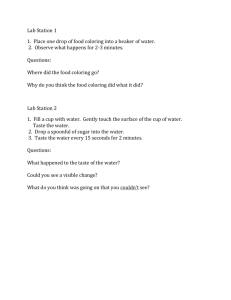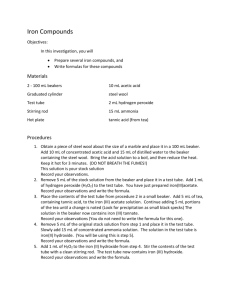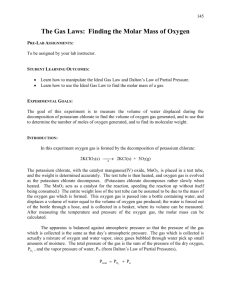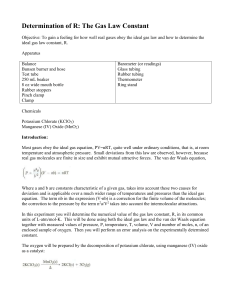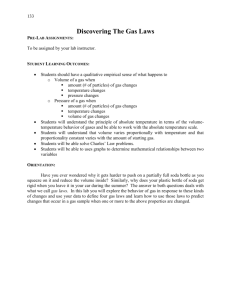Lab Report Gas Law Constant 11th Grade A.P. Chemistry
advertisement
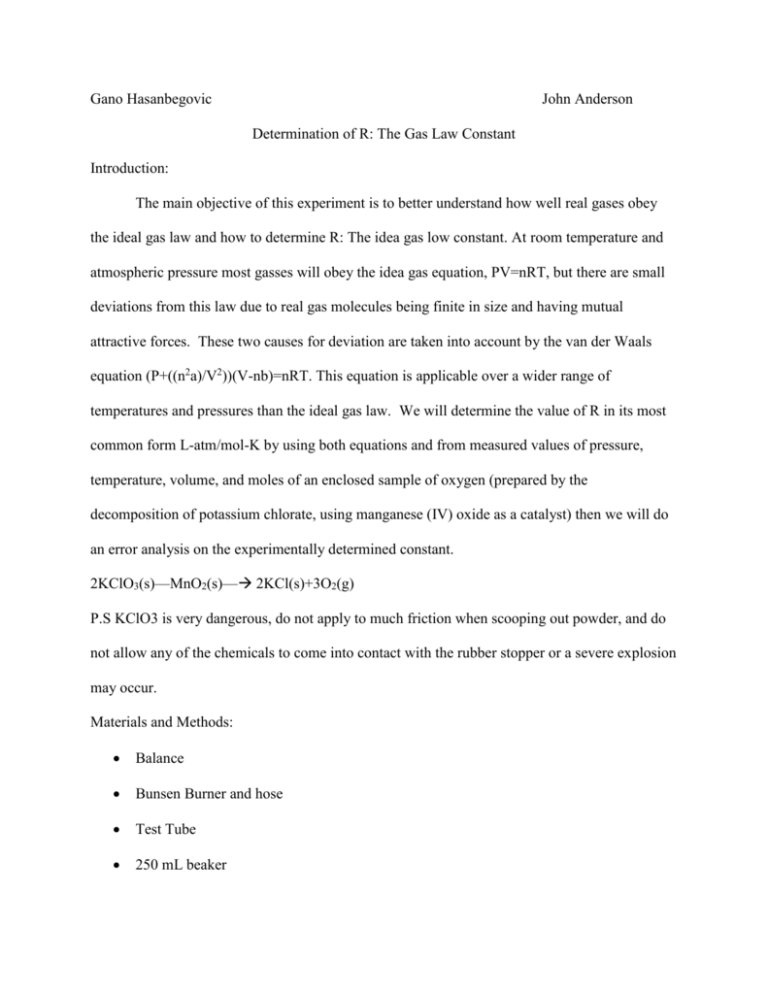
Gano Hasanbegovic John Anderson Determination of R: The Gas Law Constant Introduction: The main objective of this experiment is to better understand how well real gases obey the ideal gas law and how to determine R: The idea gas low constant. At room temperature and atmospheric pressure most gasses will obey the idea gas equation, PV=nRT, but there are small deviations from this law due to real gas molecules being finite in size and having mutual attractive forces. These two causes for deviation are taken into account by the van der Waals equation (P+((n2a)/V2))(V-nb)=nRT. This equation is applicable over a wider range of temperatures and pressures than the ideal gas law. We will determine the value of R in its most common form L-atm/mol-K by using both equations and from measured values of pressure, temperature, volume, and moles of an enclosed sample of oxygen (prepared by the decomposition of potassium chlorate, using manganese (IV) oxide as a catalyst) then we will do an error analysis on the experimentally determined constant. 2KClO3(s)—MnO2(s)— 2KCl(s)+3O2(g) P.S KClO3 is very dangerous, do not apply to much friction when scooping out powder, and do not allow any of the chemicals to come into contact with the rubber stopper or a severe explosion may occur. Materials and Methods: Balance Bunsen Burner and hose Test Tube 250 mL beaker 8 oz wide mouth bottle Rubber stoppers Pinch clamp Clamp Barometer (or readings) Glass tubing Rubber tubing Thermometer Ring Stand 1. Pre-weigh a dry beaker. Add about 0.02g of Mno2 and about 0.3g of KClO3 to a test tube and weigh to the nearest 0.001g. 2. Add about 200ml of distilled water into the bottle. 3. Assemble the apparatus but do not attach test tube, and be sure that tube B does not extend below the water level in the bottle 4. Attach rubber bulb to tube B and apply pressure through it so that water will travel into tube A then close the clamp when Tube A is filled. 5. Mix the solids in the test tube by rotating it, making sure none of the mixture is being lost from the tube, and attach tube B. 6. Fill beaker about half full of water, insert tube A in it and open the pinch clamp. Lift the beaker until the water levels are identical (to produce atmospheric pressure inside the bottle and test tube). Close clamp and discard water in the beaker, dry beaker. 7. Set beaker with tube A on bench and open pinch clamp. A little water should flow, but should stop quickly and tube A will remain filled. If that is not the case, check for leaks and start over. 8. Heat bottom of test tube gently so that a slow but steady stream of gas is produced, shown by the flow of water into the beaker. When the evolution of gas slows a lot, increase the rate of heating, then then until no more oxygen is produced. Let the apparatus cool and then equalize the water levels in the beaker and the bottle as before and close the clamp. 9. Weigh the beaker with the water and get a temperature of the water. Using the temperature, match the density and calculate the volume of water that was displaced with the chart. This is the volume of oxygen produced. Round to temperature to the nearest whole. Record the barometric pressure, the vapor pressure of the water can be found by the temperature of the water from the chart. 10. Remove test tube and weigh the tube and contents. The difference in mass from the original mass of tube and contents is the mass of oxygen produced. 11. Return the tube to the instructor for proper disposal… Results: On lab papers Analysis of Results: The value for R that we obtained was very close to the accepted value of R, and the values we obtained for R from both equations were nearly equal. From this we can presume that both the van der Waals and the ideal gas law are pretty accurate for their purposes. Some sources of error, and cause for difference from our R and the R constant, can be found when considering slightly off measurements and rounding. The scale or table rounding could be off a bit. Some oxygen might have dissolved in the water, causing the volume measurements to be off. Lastly, the constant R might have been the average constant found from the results of this experiment done numerous amounts of times. Conclusion: We accept that most gasses, at least oxygen, will behave very closely to the ideal gas law and the van der Waals equation, and that these two equations will give nearly the same results, with the van der Waals a bit more accurate. We also accept that the ideal gas law constant R is correct.





